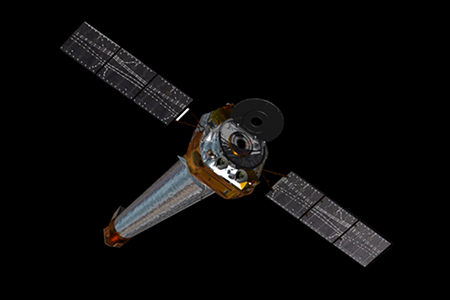Is it Easy Being Green?
Solar panels have been in the news a lot lately. First, the Space Shuttle Discovery launched to bring the final set of solar panels to the International Space Station. Then the astronauts onboard the ISS got a call from an interested member of the public - President Barack Obama - who wanted to talk,
among other things, about how the ISS uses solar power to generate its energy.
Well, as it turns out, the ISS is far from the only spacecraft up there using solar power. John Scott, a mission planner for Chandra's Flight Operation Team, describes how NASA's premier X-ray observatory is as green as can be.
In the 1999 science fiction hit "The Matrix", the future seems pretty dark. Artificial intelligence had taken over the world. Solar power has become unreliable and humans are used as batteries for the machines. Thankfully for us, this is complete science fiction and we still have the Sun and its unwavering light (that and we also haven't created machines capable of enslaving the entire human race). And, in today's reality, we are using the Sun not only to power things on Earth, but also to supply energy to our technology in space.
In the early 1970s, NASA began research on solar power with the Solar Power Satellite and the results helped pave the way for space-based solar power, including some of today's premiere NASA missions. The Chandra X-ray Observatory is one of those missions. Chandra harnesses the Sun's incident light (that is, the sunlight that falls directly) via two three-paneled solar array wings with a combined 279 square feet of gross capture capability. The non-retractable wings convert the sunlight into electrical energy to supply the spacecraft's power requirements and charge the three nickel-hydrogen (or NiH2, in chemical speak) batteries, which are used for backup power when the need arises.
With all that capability, the satellite must use a lot of energy, right? Wrong. While the solar arrays can produce a whopping 2112 watts, the logic behind the Electrical Power Subsystem (EPS) provides for extreme efficiency. Given the logic, the spacecraft currently runs at a meager 770 watts to supply power to each and every component and to charge the batteries. This 770 watts is a relatively small amount of energy when compared to other, let's say, household items. A typical toaster (800 watts) or a coffee maker (1500 watts) both run at wattages above the x-ray observatory. Even a waffle iron requires more electrical energy (nearly 1000 watts). Chandra runs at about the same wattage as a typical handheld hairdryer, which is really mind blowing when you think about it. (Imagine this. One sleeping human, snoring away in its bed, produces 75 watts of energy. So in "The Matrix", it would take 10 snoring humans and one passed out baby, all in a Boston-sized studio apartment to power the Chandra X-ray Observatory.)
However, given the orbit of the mission, there are times when the Moon or Earth is positioned directly between the spacecraft and the sunlight (known as eclipses) and therefore either inhibiting or altogether preventing the solar arrays' capability to provide energy.
The observatory experiences two eclipse seasons per year and each eclipse can last up to 100 minutes. While these lunar or Earth eclipses are short, the spacecraft must draw power from somewhere to continue capturing valuable science and protect its sensitive equipment. That's when the three batteries come into play. Just two of the three nickel-hydrogen batteries can provide about 844 watts for up to two hours of solar darkness. After traversing through the Earth or Moon's shadow and eventually back into the sunlight, the solar arrays pick up the slack again and replenish the batteries for the next eclipse. Given the length of eclipses and the number of batteries, Chandra is never at a loss for energy during these brief periods of darkness.
Essentially, the solar arrays gather sunlight, convert it to electrical power, provide the power to the spacecraft components, and recharge the batteries in the most efficient ways possible. In turn, the spacecraft performs its job and provides us with some of today's most fascinating science data, allowing us to explore the Universe one photon at a time.
John Scott, NGST
Please note this is a moderated blog. No pornography, spam, profanity or discriminatory remarks are allowed. No personal attacks are allowed. Users should stay on topic to keep it relevant for the readers.
Read the privacy statement

